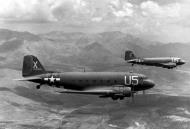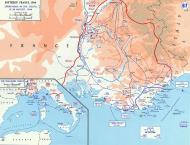US Navy Hellcats shots down a number of German planes during Operation Anvil in 1944.
In the early morning hours of August 15, 1944, the invasion of southern France began — Europe’s second “D-Day”, called Operation Dragoon. Though little known among those who enjoy reading of the Normandy landings, Operation Overlord, the invasion of southern France was a decisive victory that was hard fought. Notably, it also involved air support from the US Navy, thus putting Grumman F6F-5 Hellcats over France in direct contact with the German Luftwaffe.
USAAF C-47A Skytrains from the 12th Troop Carrier Wing, loaded with paratroopers on their way for the invasion of southern France during Operation Dragoon. Photo Credit: USAF
For the Allies, Operation Dragoon was a complete success. The combined forces of the US/UK 1st Airborne Task Force parachuted into the hills overlooking the beaches in the vicinity of St. Tropez, east of Marseille. The parachute drop was followed by a morning amphibious assault by the U.S. Seventh Army. A day later, the French First Army would land on the beaches and the drive inland would begin. The German Forces of Heeresgruppe G (Army Group G) were ill-equipped, spread thinly and under supplied. Resistance forces had severed communications and the speed of the Allied invasion and drive inland had taken them by surprise.
Within days, the most capable elements of Heeresgruppe G would make a retreat toward Switzerland, leaving behind to surrender 130,000 soldiers, including many from the East, and third tier forces. Throughout this period, extensive resupply operations were also flown by the Allies, as C-47s made hundreds of sorties to bring needed ammunition, food and equipment to the men engaging in battle across the region. Because of Operation Dragoon, the Allies were able to liberate all of France within just four weeks, opening the southern ports along the Mediterranean for logistics supply into France to support the drive toward Berlin — later calculations estimate that 1/3 of all logistics support for the advance landed in southern France.
Yet overhead, an unexpected and little known battle played out as US Navy F6F-5 Hellcats flew missions over Europe. On August 15 alone, the first day of the invasion, 100 sorties were flown over beaches and inland, virtually all in the ground attack role. Launching from the USS Tulagi, the Hellcat squadron VOF-1 under the LCDR W.F. Bringle, USN, and VF-74 from the USS Kasaan Bay under the command of LCDR H. Brinkley Bass, USN, provided coverage for the ground forces. In addition, a small seven plane night fighter unit of F6F-3N Hellcats with radar systems were employed from a detachment based on Corsica — each night, two would land on the USS Tulagi to stand readiness on deck in the event of an incoming night attack (they were never needed). On D-Day, the USS Tulagi’s first launch of Hellcats over France would take place at 5:46 am with the dawn. By the end of the operation, VOF-1 would have flown 68 missions and fully 276 sorties — VF-74 too would fly a similar number.
The German Luftwaffe, however, did not make much of a showing to challenge the US Navy in the skies. On the first evening off Cap Dramont, a Ju-88 sank a fully loaded tank landing ship (USS LST-282) by using a glide bomb. On D-Day+2, another set of torpedo attacks by Dorniers and Ju-88s were unsuccessful after the attackers encountered heavy AAA fire. Despite the sporadic air response, however, anti-aircraft were more successful against the American pilots. Finally direct contact between the Luftwaffe and US Navy occurred on August 19, when in the morning, three Heinkel He-111s were seen by a flight of four Hellcats from VOF-1. With critically low fuel, however, they could not engage. It became apparent that the German retreat was now underway — the roads at Remouline were snarled with traffic as a large German convoy pressed northward out of the battle area. The Hellcats were launched and strafed and bombed the convoy to great effect, what would later be called “a devastating attack”.
Later in the day, two more He-111s were spotted by another flight of Hellcats from VOF-1 and both were shot down near the village of Vienne, marking the first Hellcat “kills” over France. Shortly afterward, a third He-111 was spotted and also downed by one of the same VOF-1 pilots, Ensign Wood, who chalked up his second victory for the day, though the first was officially shared with his squadron mate, LT Poucel. Then VF-74′s commander, LCDR Bass, lead a flight that intercepted and downed a Junkers Ju-88. As the afternoon hours ticked by, another VF-74 flight encountered a Dornier Do-217 and shot it down as well, with the victory being shared by two Navy pilots, LTJG Castanedo and ENS Hullard.
The US Navy enjoyed complete dominance over the battlefield. Bloodied, the Luftwaffe put up little other resistance and indeed, the advance of the Allies on Marseille, after having been surrounded on August 21st. The Luftwaffe had attempted to fly three Junkers Ju-52 transport planes into the beleaguered city, but these too were intercepted by the Navy’s Hellcats of VOF-1 and shot down on August 21st, two by Lt. (jg.) Olszewski and the other by Ens. Yenter. Interestingly, Lt. (jg.) Olszewski’s Hellcat that day was the same one as previously flown by Ens. Wood when he scored his kills! The aircraft dutifully carried four kill markings, little Nazi swastikas, under the cockpit rail afterward.
Throughout the campaign, VOF-1 and VF-74 lost 17 aircraft and seven pilots, most due to ground fire and some due to operational accidents. VF-74′s highly experienced commanding officer, LCDR Bass, a veteran of the Pacific War who had received two Distinguished Flying Crosses, was killed during a ground attack sortie on August 20. The logbook of VF-74 recounted the loss:
“At the northernmost point of their flight, Bass’ division went low looking for targets and over Camelet, Bass suddenly pushed over steeply and at 200 feet went into a dive. The others couldn’t see his target much but thought it to be a motorcycle. Bass went so low on his strafing run that his belly tank hit an object on the ground and tore away, the plane pulled up to 300 ft. but never regained proper altitude. It pulled away to port and plummeted to earth, exploding. The only remains of Bass are his USNA ring and dogtag later found by the army in the field where he crashed.”
Despite the losses, the Navy’s Hellcats proved effective in their primary roles of air superiority as well as ground attack over France. In the latter role, they were particularly deadly, strafing and bombing targets with the results being 825 vehicles destroyed, 334 more damaged and the destruction or damage of 84 locomotives. Eight Luftwaffe aircraft were downed in total. After two weeks, the US Navy’s air units were withdrawn from the combat as the supporting amphibious fleet was no longer needed.
One More Bit of Aviation History
During the war in Europe, other carrier-based aircraft that were well-known in the Pacific War but rarely seen fighting the Germans were engaged. The FM-2 Wildcat was a standard fixture of convoy support duties with a number of squadrons engaged. The British also flew the Wildcat, calling it the Martlet, basing the plane out of Scotland. They felt that the FM-2 Martlets were no match for the Luftwaffe. Also, during Operation Torch, the invasion of North Africa, US Navy Wildcats were engaged against Vichy French fighter planes, scoring a number of kills. After the successful invasion, the bulk of the remaining Vichy French forces there came over to fight with the Allies as part of the Free French forces, making their losses even more pointless.
US NAVY CLAIMS, 19 AUGUST 1944
Eight F6F-5s of VF-74 took off from the escort carrier Kasaan Bay (CVE-69) at 06.25 local time for an armed reconnaissance of the Rhône Valley ahead of the advancing armies. An hour into their mission they encountered a Ju 88 north of Valence. It was heading north at 2,500 feet and reportedly lacked camouflage although it carried crosses and swastikas. It was subjected to repeated runs by four American fighters, offering no return fire and taking minimal evasive action before its engines caught fire, it crashed and exploded. This, the first US Navy fighter kill in Europe, was shared between four pilots: Lt. Cdr. Bass, Lt. Horacek, Lt.(jg) Castanedo and Ens. Pavlovich.
Six more VF-74 Hellcats on patrol to the Clermont-Ferrand area (which would be liberated inside a week) shot down an eastbound Do 217 with “brown mottled camouflage” near Issoire at 17.50 hrs. local time. There was no defensive fire and the Dornier exploded on impact. This encounter almost certainly corresponds with the reported loss of Fw. Krag and six other aircrew of Erprobungsgruppe 100, reported missing that day from Toulouse. The victory was jointly credited to Ens. Hulland and Lt. Castanedo.
Just 25 minutes later, F6F-5s of VOF-1, flying from the USS Tulagi (CVE-72) reported meeting two He 111s heading due south. VOF-1 had both artillery-spotting and fighter roles. In fulfilment of the latter they gave chase, noting that the hostiles carried German crosses and were “grey with black camouflage spots.” The German aircraft split, Lt. Poucel and Ens. Wood shooting down the first of them. Lieutenant Commander Sandor and Ens. Robinson then fired on the other, causing it to crash in a field. The Americans strafed the downed machine, killing members of the crew who emerged from the wreck. A third Heinkel was spotted going north at low level and Wood was able to destroy that one as well; it crashed in woods. On the homeward flight, Poucel was able to strafe a Ju 88 in a revetment on an airfield near Montélimar.
Apart from the Do 217, known Luftwaffe bomber casualties for the day were five men of I./KG 26 killed, while from II./KG 26 there were nine dead, two wounded, one wounded and taken prisoner. This would be equivalent to four crews (plus one passenger) although both Gruppen were equipped with the Ju 88 rather than the He 111. However, Paul Mathevet has pubished a photograph of the rear part of an He 111 which crashed at Chonas l’Amballan (Isère) on this date, identifying it as W.Nr. 110280. It is camouflaged in a pale meander over a darker base and is clearly marked 1H+EC, codes tying it to Stab II./KG 26. The five crew are reported to have set the Heinkel on fire and joined German troops on the nearby Route Nationale 7.
NOTE: Stab II./KG 26 had at least one other Heinkel, He 111 H-11 W.Nr. 110147, 1H+DC, which was flown from Celle to Vechta early in September for changes to its equipment.
Evelyne Py, a historian of the Lyon region, passed on information about the crash of a German aircraft on 19 August 1944, in the Tournon/Mauves area (in the Ardèche, north of Valence). She reports that there was a woman aboard whose name, according to her papers was Catherine Pomm.
https://www.quora.com/During-WWII-was-there-any-combat-between-US-Navy-fighters-and-German-aircraft

 Editor for Asisbiz: Matthew Laird Acred
Editor for Asisbiz: Matthew Laird Acred



